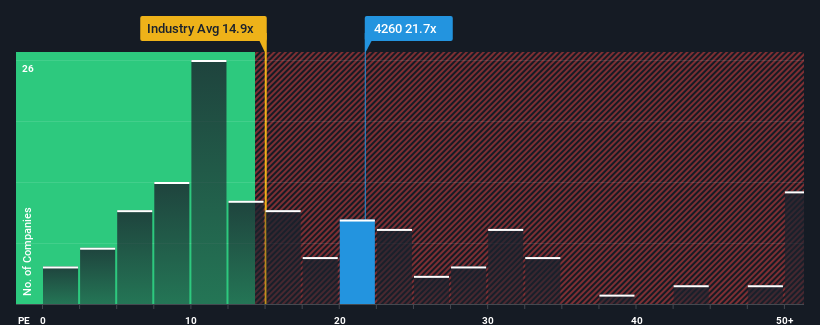- Saudi Arabia
- /
- Transportation
- /
- SASE:4260
United International Transportation Company (TADAWUL:4260) Screens Well But There Might Be A Catch

United International Transportation Company's (TADAWUL:4260) price-to-earnings (or "P/E") ratio of 21.7x might make it look like a buy right now compared to the market in Saudi Arabia, where around half of the companies have P/E ratios above 26x and even P/E's above 42x are quite common. Nonetheless, we'd need to dig a little deeper to determine if there is a rational basis for the reduced P/E.
Recent earnings growth for United International Transportation has been in line with the market. One possibility is that the P/E is low because investors think this modest earnings performance may begin to slide. If you like the company, you'd be hoping this isn't the case so that you could pick up some stock while it's out of favour.
Check out our latest analysis for United International Transportation

What Are Growth Metrics Telling Us About The Low P/E?
The only time you'd be truly comfortable seeing a P/E as low as United International Transportation's is when the company's growth is on track to lag the market.
If we review the last year of earnings growth, the company posted a worthy increase of 6.5%. Pleasingly, EPS has also lifted 35% in aggregate from three years ago, partly thanks to the last 12 months of growth. Therefore, it's fair to say the earnings growth recently has been superb for the company.
Looking ahead now, EPS is anticipated to climb by 13% per year during the coming three years according to the five analysts following the company. That's shaping up to be similar to the 14% each year growth forecast for the broader market.
With this information, we find it odd that United International Transportation is trading at a P/E lower than the market. Apparently some shareholders are doubtful of the forecasts and have been accepting lower selling prices.
The Bottom Line On United International Transportation's P/E
Using the price-to-earnings ratio alone to determine if you should sell your stock isn't sensible, however it can be a practical guide to the company's future prospects.
We've established that United International Transportation currently trades on a lower than expected P/E since its forecast growth is in line with the wider market. When we see an average earnings outlook with market-like growth, we assume potential risks are what might be placing pressure on the P/E ratio. It appears some are indeed anticipating earnings instability, because these conditions should normally provide more support to the share price.
A lot of potential risks can sit within a company's balance sheet. Take a look at our free balance sheet analysis for United International Transportation with six simple checks on some of these key factors.
If P/E ratios interest you, you may wish to see this free collection of other companies with strong earnings growth and low P/E ratios.
New: AI Stock Screener & Alerts
Our new AI Stock Screener scans the market every day to uncover opportunities.
• Dividend Powerhouses (3%+ Yield)
• Undervalued Small Caps with Insider Buying
• High growth Tech and AI Companies
Or build your own from over 50 metrics.
Have feedback on this article? Concerned about the content? Get in touch with us directly. Alternatively, email editorial-team (at) simplywallst.com.
This article by Simply Wall St is general in nature. We provide commentary based on historical data and analyst forecasts only using an unbiased methodology and our articles are not intended to be financial advice. It does not constitute a recommendation to buy or sell any stock, and does not take account of your objectives, or your financial situation. We aim to bring you long-term focused analysis driven by fundamental data. Note that our analysis may not factor in the latest price-sensitive company announcements or qualitative material. Simply Wall St has no position in any stocks mentioned.
About SASE:4260
United International Transportation
Engages in the leasing and rental of vehicles, and used car sales under the Budget Rent a Car name in Saudi Arabia.
Proven track record and fair value.
Similar Companies
Market Insights
Community Narratives




